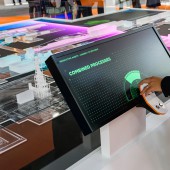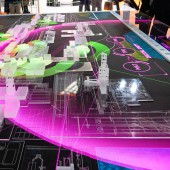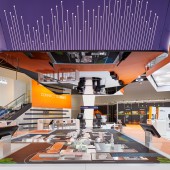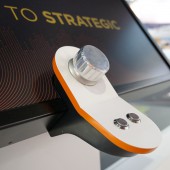Steel City Tradeshow Highlight by Responsive Spaces |
Home > Winners > #89866 |
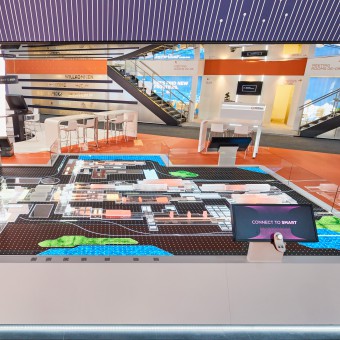 |
|
||||
| DESIGN DETAILS | |||||
| DESIGN NAME: Steel City PRIMARY FUNCTION: Tradeshow Highlight INSPIRATION: Our inspiration for this project was to merge the necessity of visualizing extremely complex processes with an easy to use and intuitive haptic interface. The goal was to have an installation that would deliver expert knowledge on point and at the same time act as an visual highlight of the stand while maintaining the structural complexity of its professional use-cases. We wanted to merge a magical experience with a top notch user experience into a tool that serves the expertise of our client and helps them to deliver this expertise effortless to all visitors at the trade show stand. UNIQUE PROPERTIES / PROJECT DESCRIPTION: The operation of the Steel City is bound to a unique rotary knob: While turning, several "steps" can be felt as "real" physical resistance. These are not analog in nature, but instead are generated through a magnetized liquid inside the knob's housing and can be programmed in realtime. The knob is programmed to adapt accordingly to every selected content and therefore enabling the experts from Primetals to focus on their visitors without ever taking their eyes off the presented stories. OPERATION / FLOW / INTERACTION: By selecting one of 12 scenarios at 4 terminals users can trigger animated sequences on the led-wall, which visualize the processes and work-flows of a steel plant in a firework of light and color. Steel is processed, data packets buzz through virtual lines, problems and solutions are displayed schematically and in context, always projected through the acrylic models on top. While the Steel City blends all stories perfectly, the terminals offer in-depth details to the individual users. PROJECT DURATION AND LOCATION: June 2019 in Duesseldorf at METEC 2019 FITS BEST INTO CATEGORY: Interface, Interaction and User Experience Design |
PRODUCTION / REALIZATION TECHNOLOGY: Over 200 different semi-transparent acrylic 3D-models were designed and manufactured depicting the model of a modern steel plant and were placed on a 24 sqm led-wall. The interfaces of the terminals around the Steelcity are specifically designed and built for the purpose of a haptic and intuitive user-experience. On top of the installation is a special reflective material, which mirrors the whole visualization of the acrylic models on the led-wall and projects it towards the far corners of the stand, giving everybody an additional perspective. SPECIFICATIONS / TECHNICAL PROPERTIES: Over 200 acrylic 3D-models of a steel plant positioned upon a 6,5 x 4,5 meter led-wall, which is positioned horizontally between 4 interactive terminals. Every terminal utilizes a rotational knob featuring haptical feedback that changes in realtime corresponding to its navigational state. Cubic dimensions of the whole installation: 8m x 5m x 5,5m. The led-wall is raised 60cm from the floor, housing the hardware necessary for operating the installtion beneath. TAGS: haptic interface, digital staging, interactive installation, digital enhanced acrylic models RESEARCH ABSTRACT: One of the research objectives was to develop an interface which can be programmed in real-time for the haptic rotary knob. We developed an in-house protocol which is able to communicate changes in the haptic structure to the hardware on the fly corresponding to the content on-screen. Another objective was to simplify the immensely complex processes and mechanisms of a steelplant to a stylized level which can be transported onto our model and create a visual language that is at the same time beautiful to watch and informative on a professional level. CHALLENGE: While our client is highly specialized in the field of steelworks and thus needed to communicate complex technical information to its own clients and partners, we still wanted to maintain a very productive level of minimalism for this installation in order to deliver their messages in a crystal-clear and visually aesthetic manner. Also, for the people operating the terminals and navigating through the different use-cases, we needed a haptic interface that is simple enough, yet incredibly responsive to the user in order for them to fully concentrate on the dialog with their customers. ADDED DATE: 2019-07-27 11:02:36 TEAM MEMBERS (4) : Director: Markus Pargfrieder, Spatial Experience Developer: Katharina Mayrhofer, Interface Engineer: Julian Reil and Spatial Experience Designer: Martin Zeplichal IMAGE CREDITS: Photo credits: Responsive Spaces & Philip Kistner Fotografie Video credits: Responsive Spaces & Eyup Kuş |
||||
| Visit the following page to learn more: http://bit.ly/2ylzmcr | |||||
| AWARD DETAILS | |
 |
Steel City Tradeshow Highlight by Responsive Spaces is Winner in Interface, Interaction and User Experience Design Category, 2019 - 2020.· Press Members: Login or Register to request an exclusive interview with Responsive Spaces. · Click here to register inorder to view the profile and other works by Responsive Spaces. |
| SOCIAL |
| + Add to Likes / Favorites | Send to My Email | Comment | Testimonials | View Press-Release | Press Kit | Translations |

